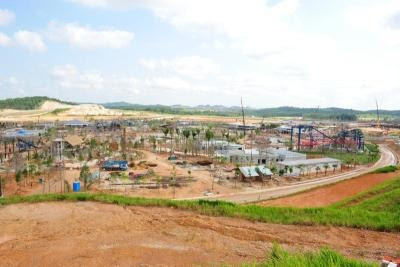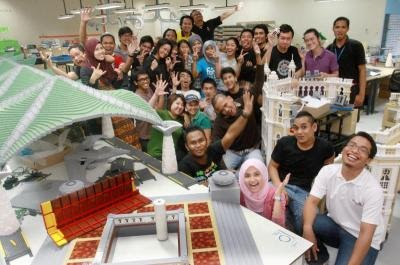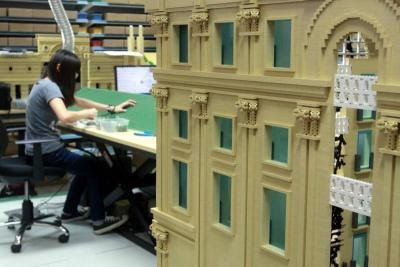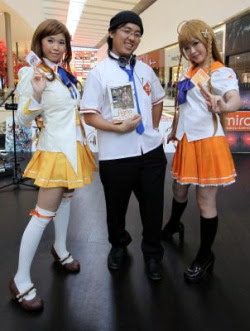Terrapuri celebrates Terengganu's rich architectural and cultural heritage
Story and pictures by Andrew Sia
Monday September 24, 2012
Terrapuri is no ordinary conservation and restoration project. It celebrates the rich architectural and cultural heritage of Terengganu
A Chinese businessman has been collecting antique Malay houses for 20 years, and he has now turned them into a lovely heritage-themed boutique resort called Terrapuri, which means The Lan d of Palaces.
The location he has chosen is Penarik, an hour's drive north of Kuala Terengganu. This stunning site sits on a narrow spit of land sandwiched between a riv er lined with nipah sugar palms and the glistening sea graced by gently swaying coconut trees, all capturing the windy whispers from the South China Sea.
Just off-shore lie the island jewels of Pulau Redang, Pulau Lang Tengah and Pulau Bidong, each graced with necklaces of liquid gemstone in the form of luminous aquamarine waters.
The intrepid collector is Alex Lee Yun Ping, 44, a self-made entrepreneur who runs the state's largest tour company, Ping Anchorage Travel & Tours. Now he has created a little slice of paradise with 29 aged Terengganu ho uses which have been transformed into luxurious villas, as well as a spa, Malay restaurant, meeting centre, reception, library and art gallery.
Such is the weight of architectural treasure here that Terrapuri has been used to shoot the Malaysia Truly Asia advertisement, as well as the Malay epic film Hikayat Merong Mahawangsa. But this is certainly no ordinary conservation and restoration project. Rather, it's meant as a model living heritage used and enjoyed by guests every day.
The villas have many of the modern comforts one expects – air-conditioning, hot showers, mini fridge, kettle, etc – amidst a setting of real antiques such as woode n gerobok (cupboards), brass trays, earthen jars and wooden chests. I choose to switch off t he air-con and open the carved wooden windows, the better to feel the sea breeze from the nearby beach, while safely protected from mosquitoes inside my kelambu (mosquito net) over the bed.

Alex Lee prying open some live oysters
as pre-dinner appetiser on a floating
fish farm near Terrapuri.
Traditional Malay ho uses have a rumah dapur, the wet part of the house which is usually a bit lower than the main house. At Terrapuri, this has been cleverly transformed into a large and luxurious bathroom complete with a wooden bathtub. This is precisely where I opt to dissolve the stress I have carried over from KL.
Alex, as he prefers to be known, is an antique collector who just happens to gather whole houses! This has been possible not only because traditional Terengganu homes are made of extremely durable cengal wood but, more importantly, because they can be dismantled and reassembled.
"Not a single nail is used to build the houses, " he explains. "Instead, the beams are fitted together using pasak (wooden pegs). Even the walls are made of timber panels slotted into grooves (in the beams)." (You can see this being done in the iSnap video).
This portability has enabled him to scour the state looking for time-honoured homes, some with colourful stories. Take the t wo grand houses named Teluk Pasu and Teluk Rusa. They were built 150 years ago by one Haji Mohd Ali, a 19th century rags-to-riches merchant who made his fortune from making pelara (fish fermented with salt to make a sauce) along the coast and then sending boats upriver to barter it with rice, fruits, and other jungle produce. Now the twain are in the process of being converted into the resort's library and art gallery respectively.
It was back in 1988, after Alex had just turned part of his grandparents' wooden shop in Marang (a small town 20km south of the state capital) into a backpackers' inn, that his foreign guests began influencing him to better value local culture, arts and architecture.
"In those days, we Asians did not appreciate our own things much. Old wooden houses were allowed to rot away," he recalls.
Unfortunately, this included the state authorities which decided to demolish Marang's "old and ugly" wooden shops in the early 1990s to make way for "development" with new concrete structures. The backpackers simply stopped coming to what used to be one of the must-stop destinations along the East Coast.
But Alex saw the value of these age-old structures and bought whole kampung houses, some for merely RM7,000 to RM10,000 each, as well as an array of wooden antiques such as coconut husk scrapers, looms, ploughs, carpentry tools and carvings (some of which are on display at Terrapuri).
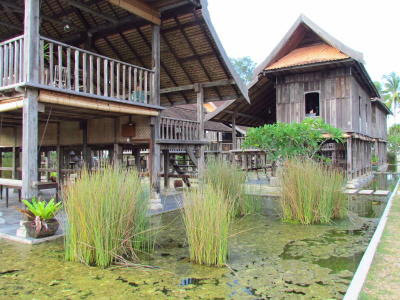
A cluster of antique Malay houses have been turned into a
fabulous heritage themed boutique resort called Terrapuri,
which means The Land Of Palaces, at Penarik, Terengganu.
He even bought half-decayed houses for the valuable cengal wood could be used as spare parts for his resort.
The classic Terengganu house, known as Rumah Bujang is built on stilts, has a steep roof, gent ly curved gable ends and rhomboidshaped terracotta roof tiles.
The level of conservation detail here can be seen with the intriguing white, red and black cloths placed at the top of several main house pillars ( which the roof beams rest on). These are the bunga halang charms which have azimat or special writings on them to ward off bad luck.
While the physical houses themselves may be over a hundred years old, they represent a much more ancient Malay culture. Alex cites the book Spirit Of Wood: The Art Of Malay Woodcarving by Dr Faris h A. Noor and Eddin Khoo, which postulates that Terengganu is heir to the rich cultural legacy of the ancient Langkasuka kingdom (2nd to the 16th century CE) which had trade and cultural links to Cambodia, Thailand, Champa (Vietnam) and Java besides China and India.

The traditional rumah dapur (kitchen) has been
cleverly transformed into a luxurious bathroom
complete with wooden bathtub.
"Malay civilisation was here even before Malacca," says Alex.
The Terrapuri project has had perhaps a more powerful knock-on effect on heritage a wareness than any seminar.
"People can now see the (monetary) value of their old houses," says Alex. "From RM10,000 about 20 years ago, an old house can now sell for RM50,000. So, nowadays, you see people keeping their old wooden homes next to their modern concrete ones."
The whole undertaking has cost him some RM10mil so far. Some of his friends called it projek orang gila (mad man's project), while his accountant kept te lling him there is little return on investment, especially with the slump in the number of European visitors due to the economic problems there. But he kept ploughing on, raising money from different quarters, even selling his Mercedes.
"For RM10mil, I could have bought five shophouses and turned them into a midrange hotel as a cash cow. My wife has also been complaining and asking why I want to suffer. But it's not just about the money. I am passionate about these old houses. They are masterpieces."
Indeed when so many places in South-East Asia offer beaches and islands, Terengganu needs an extra edge to bring in tourists and Alex believes heritage is the key.
"We face stiff competition from Thailand and Bali where cultural tourism is stronger," he notes.
Despite having applied for financial assistance from the relevant authorities for his work in preserving heritage, nothing has been forthcoming.
---> Terrapuri Heritage Village is located in Kampung Mangkuk, Penarik, 22120 Setiu, Terengganu (09-624 5020 / e-mail: info@terrapuri.com / website: terrapuri.com).
---
Preserving Terengganu's botanical and culinary heritage
By Andrew Sia
Monday September 24, 2012
An oasis of luxurious kampung living, Terrapuri also aims to preserve Terengganu's botanical and culinary heritage.
APART from the hardware of the homes themselves, the Terrapuri project is also keeping alive the crucial software of carpentry skills needed to maintain heritage homes.
Alwee Abd Rahman, 44, the resident maintenance manager, has been a carpenter since he was 13, following in the footsteps of his father Abd Rahman Abdullah.
"My father and grandfather were wood workers who made boats and houses," he says. "I learnt much from them, for instance, how to use wooden pegs instead of nails when joining wood together."
His son Alhuzaifi Alwee, 20, is, in turn, following his footsteps as an apprentice.
"As most of the kampung folks now want concrete houses, the old skills of traditional builders are being lost," says self-made entrepreneur Alex Lee Yun Ping. "Yet conservation can become a whole industry in its own right, like in Europe."
Alwee is not just preserving the past but also innovating new products. The anthology of antiques here includes many traditional Malay beds which are sized somewhere between today's Queen- and single-sized beds (requiring special mattresses to be commissioned for them).
The founder of Terrapuri, Alex (as he prefers to be called), says that since there were many more beds than needed at the resort, he discussed with Alwee how to turn some of them into benches.

An antique bed which is being converted into a bench.
Alwee Abd Rahman (left) and his son Alhuzaifi Alwee
are maintaining their family's living heritage of
carpentry skills.
"The resort could easily have just bought benches from Bali for RM400," says Alex. "But we wanted our own Terengganu identity. You won't see these benches anywhere else."
This is the place to experience kampung living in style. From breakfast on your villa's verandah with the classic Terengganu dish of nasi dagang (spicy sweet tuna curry with rice) to dinners of sup bujut (local chicken soup), ayam masak merah (tomato curry chicken) and budu (fermented anchovies) at the high Rumah Tanjung overlooking the pool and surrounding forest.
Instead of parachuting in some hotel managers from Kuala Lumpur, Alex has chosen the approach of "community-based tourism" to ensure that some income from visitors will flow towards people who live in or around Penarik. Thus tudung-clad village women provide a most homely welcome as they act as receptionists, serve food or do housekeeping, while chatting about your day's activities, or about life in Terengganu.
Food is also sourced from nearby villages, and a must-do day trip here is out to the nearby floating aquaculture farms in the river. Here, I watch Alex pulling up a whole slew of live oysters and prying them open for consumption on the spot!
The idyllic kampungs around the resort are great for cycling, and I see fishing boats, orchards, a turtle hatchery and even a breeder of ornamental cockerels known as ayam serama. In fact, the Setiu Wetlands surrounding Penarik offer a host of eco-tourism delights, including trips out to the nipah and mangrove swamps. An even more magical experience awaits me at night as fireflies on the mangroves create flashing dots of light…
Penarik is just 20 minutes from Merang jetty, the jumping-off point for day trips to the islands of Pulau Redang, Pulau Lang Tengah and Pulau Bidong. There's nothing like some snorkelling to work up an appetite!
But for something more unusual, I visit the haunting gelam forests around the resort. Alex says the movie Bunohan was filmed here, and it's easy to see why because the trees exude a mysterious charm with their gnarled barks, spindly branches and draping leaves.
Indeed, it's not just architecture that is being preserved here, but also the state's botanical (and culinary) heritage. Alex is working to create a rich garden of herbs – such as kadok leaves (used for otak otak), kelsom (laksa), ulam (salads) pandan, lemongrass, ginger, galangal, turmeric, bunga kantan (all used in curries) and the aphrodisiac tongkat ali.

The idyllic kampungs around the resort are great for cycling,
and you can see fishing boats, orchards, a turtle hatchery
and even ornamental cockerels.
Apart from the normal mango and soursop, he is also planting more "kampung" trees such as sukon (breadfruit), kerkut (which has small cherries that attract birds), cermai and gajus (both can be mixed with belacan into a condiment) and melinjau (used to make a type of local crackers). Meanwhile, the flowers from frangipani, cempaka, melor, kenanga, gardenia and kesidang trees will (once the trees mature) impart a bouquet of natural fragrances.
The wetlands on one side of the resort are rich with jambu laut, gelang, pandan laut, paku laut (cycads rumpii), kerecut reeds (which can be weaved into mats) and, of course, nipah (the leaves are used for attap roofs). And if you ever wondered what inspired Terengganu's woodcarvers to create their gloriously intricate patterns, look no further than the surrounding plants such as pepulut, sesayap, ketam guri, bayan peraksi, bakawali, kangkong and ketumbit. Yes, the plants here can be eaten, and even inspire art, too!
Indeed, it's heartening that heritage at Terrapuri is being celebrated on a deeper level beyond architecture, by delving into ancient carpentry, traditional cooking, pristine wetlands and a rich botanical inheritance.
Source: The Star Lifestyle
Terrapuri Heritage Village at Penarik, Terengganu








